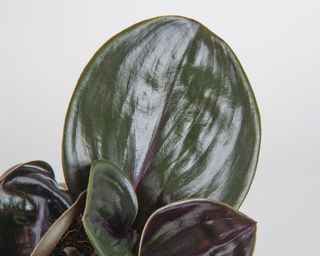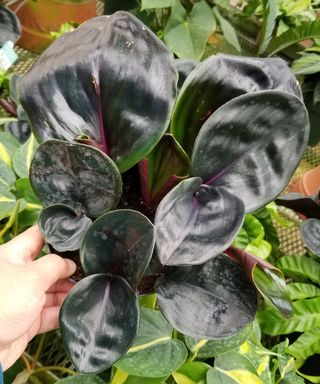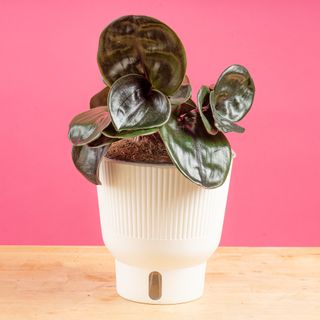If you are looking for a foliage plant with maximum impact and gothic flair, look no further than Geogenanthus ciliatus – or geo plant. This prized specimen has been making waves lately as a “new” find in the houseplant world. It hails from the Amazon rainforest, where it is part of a floral diversity many of us gardeners can only dream of.
While not technically a newly discovered plant, Geogenanthus has just recently joined the popular kids in class. It was given its botanical name in 1931 and described as a ground cover in United States Department of Agriculture lists from the 1960s.
The unusual foliage is what makes this plant stand out. Appearing almost unreal, the leaves are lush and leathery, with a near onyx hue – making geo a great companion for other foliage plants in the home. Pair it with other unique tropical houseplants and make your home feel like it’s near the steamy equator.
One of the more hard-to-find houseplants, geo is available at specialty and other plant nurseries and is well worth the search. It has recently been introduced for sale by Costa Farms after their plant hunter spied it growing in Asia and thought it had potential. Boy does it!
Costa Farms Geogenanthus in Self-Watering Planter
Part of the Trending Tropicals collection, this stunning houseplant requires little more than regular watering and is supplied in a self-watering planter to make things easier.
About Geo Plants
Quick Facts
Botanical name: Geogenanthus ciliatus
Height: 6-10 inches (15-25cm)
Spread: 12-24 inches (30-60cm)
Sun exposure: Indirect sunlight
Soil requirements: Well-draining potting soil
Hardiness zones: 11-12
When to plant: Spring
Geogenanthus ciliatus is a fairly diminutive plant that hugs the soil. It forms a mound of about 10 inches (25cm) in height. The leaves can achieve a whopping 8 inches (20cm) when the plant is mature.
It’s the leaves that have everyone cheering. Thick, lush, glossy, leathery in feel, and so deeply purple they appear black. The midrib and stems have a dusky pink hue and the leaf has faint hints of green dashed across the surface.
If conditions are perfect, barely noticeable flowers will appear in spring. The flowers rise from the ground and sport three purple petals with hairy fringes on the edges. This is where the species epithet comes from, ciliatus, “surrounded by hair”.
There are only three species in the Geogenanthus family, of which two are available as houseplants (geo plant and seersucker plant). This plant grows under the tropical tree canopy in humid, hot regions. It will need similar conditions in the home.

(Image credit: Costa Farms)
Geogenanthus Ciliatus Care
The care of Geogenanthus ciliatus is similar to the peace lily, a common houseplant with that plant’s temperamental reactions to temperature fluctuations. Geogenanthus dislikes extreme heat, but it doesn’t like it too cold either. Keep the plant in similar conditions to its cousin, Tradescantia.
Light
Geogenanthus ciliatus thrives in the morning sun with afternoon shade. Set the container just away from a window to prevent sunlight from scorching the leaves and making the plant wilt. If the plant is too near a western or southern window, use a sheer curtain to diffuse the light.
This plant will perform wonderfully, and impact everyone who sees it, in an office setting with artificial light.
Water
Geo plants prefer evenly moist soil. During the growing season, they will need water at least once per week. If the plant is near the AC it will dry out more quickly. Plants in the winter will need modest dampness but less water than during the growing season.
The specimen is tolerant of drying out but will show displeasure by wilting dramatically. This is not good for the plant and should not happen frequently. However, it will soon perk up after a good watering.
Check the soil moisture 2-3 times per week. Insert a finger down to the first knuckle, and if it feels dry, it is time to water the plant.
Like all houseplants, water to the point the liquid comes out of the drainage holes to flush out excess salts.
Consider using distilled water or allowing your tap water to off-gas on the counter for at least 12 hours. Tropical plants can be sensitive to the chemicals in municipal water supplies.

(Image credit: Shutterstock)
Temperature and Humidity
The average interior temperatures during the year are ideal for Geogenanthus. It thrives in temperatures between 65-75°F (18-25°C). You can move the plant outdoors in summer to a shady location. But avoid exposing the plant to temperatures below 50°F (10°C).
As a tropical species, the plant enjoys high humidity. If your home is on the dry side, you can increase humidity for houseplants by misting the plant daily and placing the pot on a saucer of pebbles filled with water. The water in the saucer will evaporate and moisten the air around the plant. If you are really worried, place the plant near a humidifier to simulate that steamy, tropical air.
Soil
Provide rich, organic soil with plenty of organic matter. Ideally, the soil should have some perlite or vermiculite to help trap and hold moisture. You can make your own with a mix of coir, peat moss, soil, perlite, and a bit of fine bark.
It is a good idea to repot your geo plant once per year to freshen the soil and loosen it. Over time nutrients leach out and soil compacts, reducing available oxygen for the roots.
Fertilizer
As a foliage plant, Geogenanthus needs plenty of nitrogen. A balanced houseplant food is fine or a formulation with a higher N number.
Dilute the fertilizer by half and apply twice per month in spring and summer. Or you can pop in one of those time-release spikes for houseplants that will feed the plant all season slowly.
Do not fertilize the plant in fall or winter when it is not actively growing.
This article features products available from third-party vendors on the Gardening Know How Shop.



